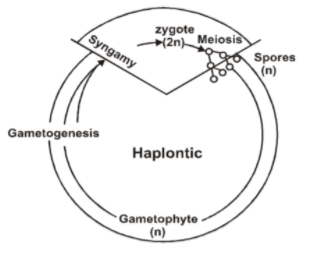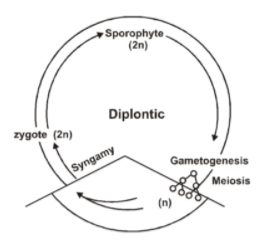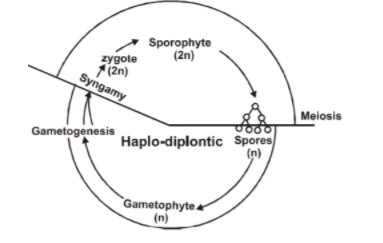
Zygotic meiosis is characteristic of
a. Prokaryotes
b. Thallophyta
c. Pteridophyta
d. Spermatophyta
Answer
585k+ views
Hint: In phanerogams, sporic meiosis is present, in which sporophyte undergoes meiosis to form haploid spores.
The zygotic meiosis is found in the haplontic life cycle, in which meiosis occurs in zygote.
The gametic meiosis occurs in some fungi, in which meiosis occurs in the cells of diploid organisms to form haploid gametes.
Complete answer: In order to solve this question, we need to know about the three types of life cycle of plants.
In plants, three types of life cycles are present- Haplontic, Diplontic and Diplohaplontic.
(a) Haplontic: In this type of life cycle, the dominant phase is haploid. The diploid phase is represented only by zygote. It shows zygotic meiosis in which meiosis occurs in zygote just after karyogamy. As a result, a diploid cell produces haploid cells. These cells divide mitotically to produce more haploid cells. In this type of life cycle, zygote is the only cell which is diploid in nature and mitosis occurs in haploid cells. It is found in Chlamydomonas, Spirogyra, Ulothrix, Dinoflagellates and most of the fungi.

(b) Diplontic: In this type of life cycle, the dominant phase is diploid. It shows gametic meiosis in which meiosis occurs in the cells of diploid individuals to form haploid gametes. These haploid gametes fuse to form diploid zygote. The diploid cells undergo mitosis to form diploid individuals. In this type of life cycle, gamete is the only cell which is haploid in nature and mitosis occurs in diploid cells. It is found in Cladophora, Acetabularia, animals and some fungi.

(c) Diplohaplontic: In this type of life cycle, both haploid phase (gametophyte) and diploid phase (sporophyte) are present. It shows sporic meiosis. The haploid gametophytes divide and form haploid gametes. These gametes fuse to form diploid zygote, which on germination gives rise to diploid sporophyte. The sporophyte undergoes meiosis and forms haploid meiospores, which on germination gives rise to haploid gametophyte. It is found in Ulva, some fungus, pteridophytes and land plants.

So, the correct answer is option B, Thallophyta.
Note: The members of green algae show zygotic, gametic and sporic meiosis.
In the life cycle of sexually reproducing organisms, alternating haploid and diploid stages are present. They show alternation of generation.
The zygotic meiosis is found in the haplontic life cycle, in which meiosis occurs in zygote.
The gametic meiosis occurs in some fungi, in which meiosis occurs in the cells of diploid organisms to form haploid gametes.
Complete answer: In order to solve this question, we need to know about the three types of life cycle of plants.
In plants, three types of life cycles are present- Haplontic, Diplontic and Diplohaplontic.
(a) Haplontic: In this type of life cycle, the dominant phase is haploid. The diploid phase is represented only by zygote. It shows zygotic meiosis in which meiosis occurs in zygote just after karyogamy. As a result, a diploid cell produces haploid cells. These cells divide mitotically to produce more haploid cells. In this type of life cycle, zygote is the only cell which is diploid in nature and mitosis occurs in haploid cells. It is found in Chlamydomonas, Spirogyra, Ulothrix, Dinoflagellates and most of the fungi.

(b) Diplontic: In this type of life cycle, the dominant phase is diploid. It shows gametic meiosis in which meiosis occurs in the cells of diploid individuals to form haploid gametes. These haploid gametes fuse to form diploid zygote. The diploid cells undergo mitosis to form diploid individuals. In this type of life cycle, gamete is the only cell which is haploid in nature and mitosis occurs in diploid cells. It is found in Cladophora, Acetabularia, animals and some fungi.

(c) Diplohaplontic: In this type of life cycle, both haploid phase (gametophyte) and diploid phase (sporophyte) are present. It shows sporic meiosis. The haploid gametophytes divide and form haploid gametes. These gametes fuse to form diploid zygote, which on germination gives rise to diploid sporophyte. The sporophyte undergoes meiosis and forms haploid meiospores, which on germination gives rise to haploid gametophyte. It is found in Ulva, some fungus, pteridophytes and land plants.

So, the correct answer is option B, Thallophyta.
Note: The members of green algae show zygotic, gametic and sporic meiosis.
In the life cycle of sexually reproducing organisms, alternating haploid and diploid stages are present. They show alternation of generation.
Recently Updated Pages
The number of solutions in x in 02pi for which sqrt class 12 maths CBSE

Write any two methods of preparation of phenol Give class 12 chemistry CBSE

Differentiate between action potential and resting class 12 biology CBSE

Two plane mirrors arranged at right angles to each class 12 physics CBSE

Which of the following molecules is are chiral A I class 12 chemistry CBSE

Name different types of neurons and give one function class 12 biology CBSE

Trending doubts
One Metric ton is equal to kg A 10000 B 1000 C 100 class 11 physics CBSE

What is 1s 2s 2p 3s 3p class 11 chemistry CBSE

Discuss the various forms of bacteria class 11 biology CBSE

State the laws of reflection of light

Explain zero factorial class 11 maths CBSE

An example of chemosynthetic bacteria is A E coli B class 11 biology CBSE




